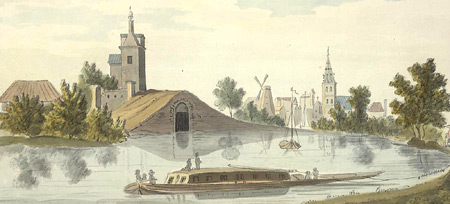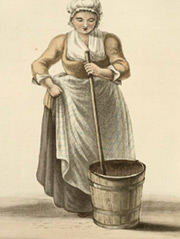England and the Netherlands: the ties between two nations > Creation of an image
Squelchy peat bog
Water is a constant factor in the image people create of the Netherlands, both in the eyes of the Dutch themselves as in those of foreigners. The Dutch character has been shaped by the amount of water and the northern, damp climate. Not only are the Dutch very good at keeping water under control, but they have also never had any scruples about cutting through dikes in order to defend themselves against the enemy, as they did at the relief of Leyden (1574). The Low Countries were a squelchy peat bog, made up of half water, half mud, according to the description given by Owen Felltham, who journeyed through the Netherlands at the beginning of the seventeenth century. That is why the English liked to compare the Dutch with frogs. Travelling and staying in the Netherlands was not always fun because of the cold and the damp. The Dutch themselves survived that damp climate by smoking tobacco, drinking alcohol and eating a lot of butter and cheese. On the other hand, the many waterways facilitated quick and efficient transportation by barge, a conveyance that some travellers loathed (because of the close contact with the lower classes in a small and stuffy space), but others praised highly.

The Dutch are still regarded as blunt and this was already so in the Middle Ages. Characterized as ‘homely’ and ‘guileless’, as ‘straightforward’ or ‘direct’ by those who wished to be positive, they were called less flatteringly ‘blunt’, ‘plump’ and ‘rude’ by the English. At the time of the Anglo-Dutch naval wars, the anti-Dutch propaganda set the English 'gentleman' against the unscrupulous, commonplace Dutchman, who “is simply vulgar and does not have any refinement”.
“The Dutch are true merchants and as such they are single-minded, opportunistic, industrious, clever and thrifty. Their work ethic is highly developed. What they lack is humour, ready wit, imagination and fantasy”.
In the seventeenth and eighteenth centuries, Dutch cruelty was also a constant factor in the view of the English; it was one of the traits on which the reaction to the Ambon murder focused. In turn, the Dutch thought the English were cruel.
In the seventeenth century, the Batavian myth was also worked up to serve as a basis for the Dutch self-image, the characteristics of the real Dutchman being his love of freedom, homeliness and cleverness.

Islanders
If the Dutch character is determined by their squelchy soil, abounding in water, the English were typical islanders. Haughty, arrogant and with a misplaced feeling of superiority, they suffered from a deeply rooted fear of foreigners and aversion for anything that was foreign. Seen from a moral point of view, it could be said that they had no backbone, were unreliable, unpredictable, capricious and disloyal. Weak, hypocritical, lazy and overly fashion-conscious. In England, women were not required to do anything: whereas the Dutch women scrubbed and cleaned, the English women lived in a real women’s paradise.
Devils, dogs and lions
The Dutch as well as the English found pleasure in calling each other devils. The Dutch were devils who lived conveniently near to hell on their swamps below sea level, which came in handy when they died. As for the English, the Dutch made a connection between Engelsen and engelen, the Dutch word for angels, but then fallen angels. That is why the English were sometimes called ‘tail men’: angels with tails, devils. They had a retinue of dogs (often bulldogs or bloodhounds). The counterpart of the English bulldog was the Dutch lion. In Owen Felltham’s writings, it was exactly the opposite: the ‘Indian mastiff’’ (the Dutch in the East) behaved cruelly and fiercely towards the 'angry lion' (England).
> Read on: Dutchmen in England
< Go back to: Eyewitnesses
